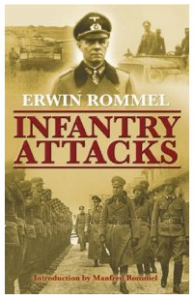A superb insight into infantry tactics at company and platoon level.
When you notice that the author of this book is Erwin Rommel, you might think of the German desert fox who fought Montgomery and Patton in North Africa during World War II.
 However, in World War I, the same Erwin Rommel was an infantry commander. “Infantry attacks” is his highly recommended analysis of his own combat experience.
However, in World War I, the same Erwin Rommel was an infantry commander. “Infantry attacks” is his highly recommended analysis of his own combat experience.
Rommel begins and builds his book with a description of his unit’s actions and closes the chapters with relevant observations – what we, today, would refer to as lessons learned.
The most interesting chapter is his description of the Battle of Caporetto. Commanding a detachment no larger than a company, Erwin Rommel won the Pour Le Mérite (the Blue Max), Germany’s highest ranking medal, for leading the attack and taking 1,500 men and 43 officers prisoner.
Published in 1937, the book was thought of as a textbook on infantry tactics in the German army. Thankfully Rommel himself is not afraid to admit failure. He identifies the lessons to be learned, states it as an observation and moves on.
If you are thinking: – Well, infantry tactics learned in World War I do not apply to my situation – think again! The German eastern front never came to a complete standstill as the trench warfare in France did. The tactical situations Rommel describes are full of manoeuvres, assaults and counter attacks – much of what is being taught on the trainings fields today.
Principles described by Rommel have the same value today as when the book was published in 1937:
Observation: The night attack of the Rommel detachment on the Klautana failed because the combined fire of the machine-gun company and the advance of the assault companies were not synchronized.
It sounds like Rommel is preaching fire and movement, right?
If you are interested in Rommel’s earliest exploits, want to get a different view on the trench warfare of WWI or are just interested in infantry tactics – this book should be on your bookshelf.
After the war Rommel taught infantry tactics at the military academy in Dresden and rose to end as a Field Marshal in 1944.
I read this many years ago (1985), glad to see that it is being looked at again. Time to put it back on Mount Tobereread!
Just found your blog today and it looks like a lot of good stuff. Will be back again! We’ve been having discussions on several of the subjects of your postings, so it’ll be interesting to read those.